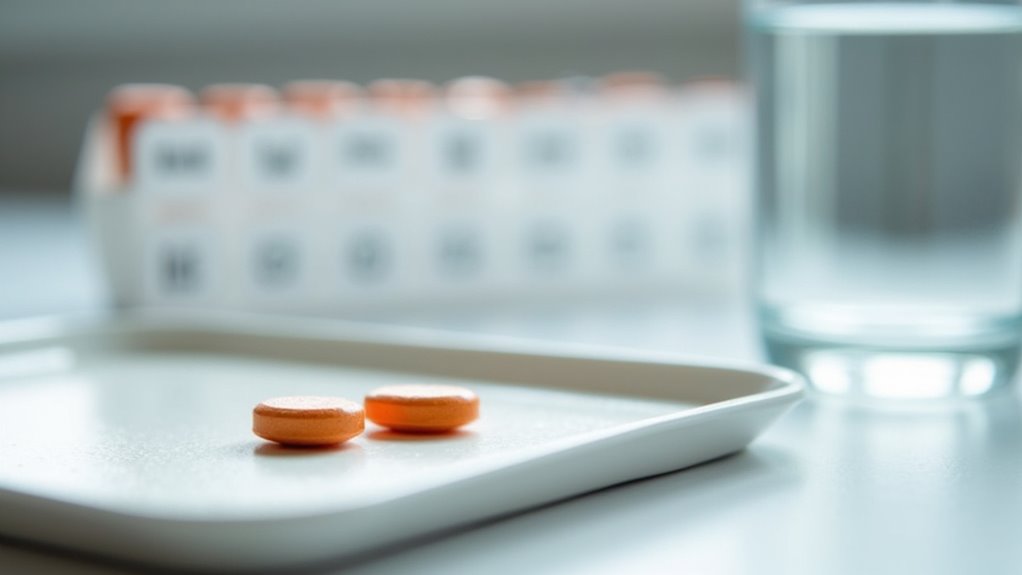Suboxone combines buprenorphine and naloxone to create an effective treatment for opioid addiction, helping you overcome dependence while preventing withdrawal symptoms. It works by partially activating opioid receptors while blocking the effects of other opioids, greatly reducing your risk of overdose. You’ll need to take it sublingually under medical supervision, with 75% of patients maintaining treatment after 24 weeks. Understanding how this medication works as part of an extensive treatment plan will strengthen your path to recovery.
The Science Behind Suboxone’s Dual-Action Formula

While many addiction treatments focus on a single mechanism of action, Suboxone’s revolutionary dual-action formula combines buprenorphine and naloxone in a precise 4:1 ratio to provide thorough opioid dependence treatment.
The therapeutic formulation’s receptor pharmacology is remarkably sophisticated. You’ll find that buprenorphine acts as a partial mu-opioid agonist, providing just enough receptor activation to prevent withdrawal symptoms without triggering the intense euphoria associated with full opioids. Meanwhile, naloxone serves as a strategic safeguard it remains dormant during proper sublingual use but activates if the medication is misused through injection. This intelligent design creates a ceiling effect that considerably reduces overdose risk while maintaining treatment efficacy. The poor gastrointestinal absorption necessitates delivering the medication sublingually rather than orally.
The combination’s synergistic properties help you maintain recovery by managing cravings and preventing relapse through consistent receptor occupation.
How Suboxone Works in the Body

Once Suboxone enters your body, it initiates a complex series of neurochemical interactions that target specific opioid receptors in your brain and nervous system. Through precise receptor binding dynamics, buprenorphine acts as a partial agonist at mu-opioid receptors while blocking kappa receptors, helping to reduce both cravings and withdrawal symptoms. The medication’s tissue distribution patterns are bolstered by its 96% protein-bound status. The drug’s ceiling effect mechanism helps minimize overdose risks compared to full opioid agonists. When taken sublingually as prescribed, the naloxone remains inactive while allowing the therapeutic benefits of buprenorphine.
| Process | Primary Location | Key Effect |
|---|---|---|
| Metabolism | Liver | CYP3A4 processing |
| Distribution | Brain/CNS | Receptor activation |
| Excretion | Digestive tract | 70% fecal elimination |
Your body processes Suboxone mainly through hepatic pathways, where it undergoes N-dealkylation and glucuronidation. The naloxone component provides additional security by deterring misuse, while buprenorphine’s high receptor affinity guarantees consistent therapeutic effects.
Key Benefits for Addiction Recovery

Building on our understanding of Suboxone’s biological mechanisms, the medication offers multiple substantive benefits for addiction recovery. Research shows you’ll experience improved treatment retention, with 75% of patients remaining in therapy after 24 weeks. You’ll also considerably less likely to use illicit opioids, especially when taking moderate doses of 8-24mg. The data demonstrates patients on Suboxone use opioids at the 16th percentile compared to those on placebo. This treatment represents a significant shift in modern addiction medicine and how we approach recovery.
Perhaps most crucially, you’ll face a substantially reduced opioid overdose risk while on Suboxone. The medication’s proven safety profile means you won’t experience increased adverse effects at higher doses, and you’ll have better protection against potentially fatal overdoses. You’ll also benefit from faster stabilization, which research links to better long-term outcomes. The combination of buprenorphine and naloxone provides a comprehensive approach to treatment by reducing cravings while deterring misuse.
Safe Administration and Usage Guidelines
The safe administration of Suboxone requires careful attention to established clinical protocols and dosing guidelines. You’ll need to place the medication under your tongue and allow it to dissolve completely for at least 10 minutes before drinking any water. It’s vital never to inject, smoke, or swallow the medication, as this can be dangerous and reduce its effectiveness.
Your healthcare provider will start you on a low dose of 2-4mg and adjust it based on your symptoms and progress. They’ll closely monitor your treatment through regular visits and urine screenings. Proper storage protocols and diversion prevention measures are indispensable – you must keep your medication in a secure location and follow your provider’s instructions regarding prescription limits and disposal. Remember, the maximum daily dose typically doesn’t exceed 16mg, though some clinics may allow up to 24mg.
Managing Side Effects and Precautions
While you’re taking Suboxone, you’ll likely experience some common side effects, including headaches, nausea, and drowsiness, which typically diminish over time. It’s paramount to monitor these effects and report any severe symptoms like respiratory depression or persistent vomiting to your healthcare provider immediately. Getting up suddenly while taking this medication may cause dizziness or fainting, so take care to rise slowly from sitting or lying positions. Incorporating complementary therapy approaches, such as cognitive behavioral therapy or support groups, can help address both physical and emotional challenges during treatment. Since Suboxone is a Schedule III medication, your doctor must have special certification to prescribe it.
You can better manage mild side effects through proper hydration, regular exercise when able, and following your doctor’s specific guidance on medication timing and dosage.
Common Side Effects Explained
Like many medications used to treat opioid dependence, Suboxone can cause numerous side effects that patients should monitor closely. You may experience physical symptoms such as headaches, dizziness, sweating, or fever, while gastrointestinal issues like nausea and vomiting are also common. Individual risk factors can influence how your body responds to treatment. You can access more information about managing side effects and prescription costs through GoodRx in America only.
Central nervous system effects, including insomnia affecting 14% of patients, mental impairment, and anxiety, may occur. You’ll need to watch for opioid-related symptoms such as rapid heart rate and body aches. Managing dosage adjustments is essential, as serious complications like respiratory depression can affect 1-10% of patients. Your healthcare provider should monitor you for potential liver damage, heart rhythm abnormalities, and low adrenal hormone levels throughout your treatment.
Essential Safety Precautions
Managing Suboxone treatment safely requires careful attention to multiple precautionary measures that protect both you and your loved ones.
You’ll need to follow strict storage safety protocols by keeping your medication in locked containers and original blister packs until use. Never share your prescription with others, even if they’ve similar symptoms. When you’re finished with treatment, utilize FDA-approved take-back programs for proper medication disposal methods.
If you’re taking other medications, inform your healthcare provider about them, especially benzodiazepines or CNS depressants, as these combinations can be dangerous. You’ll need regular monitoring, including liver function tests and respiratory assessments. For pregnant patients, special considerations apply due to potential neonatal withdrawal risks. Regular dental checkups are essential to prevent damage to teeth and gums that can occur with sublingual film use. Remember to attend all scheduled check-ups and report any concerning symptoms immediately to your healthcare team.
The Role of Professional Medical Supervision
Professional medical supervision forms the cornerstone of safe and effective Suboxone treatment, requiring strict adherence to federal regulations and clinical protocols. You’ll need ongoing oversight from a DEA-registered provider who meets current regulatory compliance requirements, including completion of specialized OUD training and maintaining proper licensing for controlled substance prescribing.
Regular check-ins with your clinician to monitor treatment progress and adjust dosing
Thorough evaluations including substance use history and mental health assessments
Mandatory laboratory testing and liver function monitoring throughout treatment
Structured medication agreements and electronic prescription protocols
Consistent screening for potential complications or adverse effects
Patients have the convenience of accessing treatment through telehealth appointments that provide the same level of care as in-person visits.
Under proper clinician supervision protocols, you’ll receive carefully monitored care that includes risk assessment, dose titration, and ongoing evaluation of your response to treatment. This medical oversight helps safeguard your well-being while maximizing treatment effectiveness and supporting your recovery course.
Combining Treatment With Behavioral Therapy
Successful Suboxone treatment requires more than medication alone – it demands a thorough approach that combines pharmacological intervention with behavioral therapy. When you’re committed to recovery, behavioral therapy works alongside Suboxone to address both physical and psychological aspects of addiction, improving treatment adherence and reducing relapse risk.
Through therapy, you’ll develop essential coping mechanisms, process underlying trauma, and learn to recognize triggers that could lead to substance use. While research shows mixed outcomes regarding the benefits of combined treatment, many studies indicate that therapy bolsters the effectiveness of Suboxone by addressing environmental influences and strengthening support networks. Cognitive Behavioral Therapy helps identify and replace negative thought patterns that contribute to addictive behaviors. Studies suggest that medication management alone may be a more cost-effective approach for treating opioid use disorder. Motivational interviewing and other therapeutic techniques provide vital tools for maintaining recovery momentum.
You’ll work on rebuilding relationships, setting meaningful goals, and developing practical strategies for maintaining long-term sobriety. This extensive approach helps foster sustainable recovery by treating addiction’s complex, multidimensional nature.
Long-Term Recovery and Treatment Success
Long-term studies reveal encouraging outcomes for individuals who maintain consistent Suboxone treatment as part of their recovery path. Research shows that treatment adherence markedly improves sustained outcomes, with continuous users experiencing a 173% lower overdose risk and 128% reduction in opioid-related hospitalizations. When combined with proper medical supervision, Suboxone treatment can lead to remarkable recovery rates.
Research confirms Suboxone’s effectiveness, with consistent treatment reducing overdose risk by 173% and opioid hospitalizations by 128% among committed patients.
- 60% of patients maintain abstinence at 3.5 years, with half successfully discontinuing medication
- Extended 12-week treatment shows superior results compared to short-term detox approaches
- Continuous treatment reduces emergency department visits and inpatient stays by up to 52%
- Treatment adherence correlates with lower relapse rates and improved stability
- Individualized treatment duration optimizes success rates across different patient populations
You’ll find that proper dosing strategies and consistent monitoring help manage side effects while maximizing treatment benefits.
Frequently Asked Questions
Can I Travel Internationally While Taking Suboxone?
Yes, you can travel internationally while taking Suboxone, but you’ll need to follow proper storage guidelines and understand potential travel restrictions. Always carry your original prescription, a doctor’s letter, and documentation translated for your destination country.
Keep medications in their original packaging and limit your supply to 90 days. Research your destination’s regulations carefully, as some countries restrict or prohibit Suboxone. Consider consulting your healthcare provider for specific travel recommendations.
How Much Does Suboxone Treatment Typically Cost Without Insurance?
Without insurance, your out-of-pocket expenses for Suboxone treatment typically range from $30 to $540 monthly, depending on your dosage and whether you choose brand-name or generic options.
You’ll find generic tablets are more affordable at $90-$240 monthly for lower doses. Don’t forget to investigate financial assistance programs, manufacturer coupons, and sliding-scale clinics that can help reduce costs. Many providers offer cash payment plans to make treatment more manageable.
Will Suboxone Show up on Employment Drug Tests?
Standard employment drug tests typically won’t detect Suboxone unless specifically testing for buprenorphine. While 5-panel and 10-panel tests don’t include it, some employers may request specialized screening.
If you’re prescribed Suboxone, you’re protected under ADA regulations and can provide documentation from your healthcare provider. It’s crucial to be aware that potential drug interactions and discontinuation symptoms could affect your test results, so always disclose your prescription status beforehand.
Can I Switch From Methadone to Suboxone Treatment?
Yes, you can switch from methadone to Suboxone, but it’s a process that requires careful medical supervision. You’ll need to reduce your methadone dose to 20-40mg per day before moving.
Your doctor will help manage withdrawal symptoms and make necessary dosage adjustments during the switch. The changeover typically involves a 3-6 day waiting period after your last methadone dose before starting Suboxone.
Always work with your healthcare provider to guarantee a safe changeover.
How Long Does It Take to Completely Taper off Suboxone?
Your tapering timeline depends primarily on your starting medication dosage and individual response to withdrawal. If you’re on a lower dose (under 8mg), you might complete tapering in 4-6 weeks.
However, if you’re on a higher dose (16mg or more), you’ll likely need 45+ days for a safe taper. Remember, there’s no universal schedule you’ll work with your doctor to create a personalized plan that minimizes withdrawal symptoms and optimizes your success.






